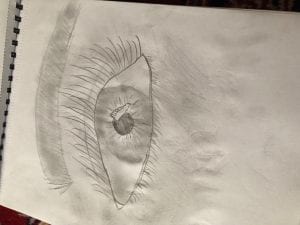Art and emotion flow by the river.
Early morning drivers pull up and prepare their clients to start their day at Community Connections, which is located right near the Taunton River. Observing the general manner of the employees puts one at ease when you see the clients’ reactions with friendly smiles and high fives. Community Connections is a day habilitation program for adults with intellectual and/or physical challenges. When you enter the building, big, glass, double doors automatically open. There’s wall to wall art crafted by the clients, and vaulted ceilings as you walk down the hall. The art represents togetherness and friendship shared by the clients and the employees. On either side the hallway there are a series of rooms. The top half of the walls are painted teal and there are shiny, wood floors. Large exposed beams cross from one side of the hallway to the other, making the highest peak of the ceiling easy to see. Depending where you are the flooring changes. The kitchen has raised rubbery skid proof flooring, and the music and game room have almost foamy floor covering to reduce injury from possible falls. In every room you walk in there’s corresponding visual themes. Such as the man on the moon in the space room offsetting the planets and the treadmill that walks you towards Mars. In the music room there are instruments hanging from the beams mobile style. Brick walls surround the room and shelves keep the laptops and tablets secure but accessible. A desktop computer is surrounding by shelves holding several music CD’s, hand held electronic toys and hand held instruments. I saw maracas, tambourines, electronic drums, and eggs that make noise when you shake them. The game room has a bright orange floor, bean bag chairs and low tables so everyone can sit around and play board games.
My sister loved the bunny, Lois not so much.
The reason I go to Community Connections is because my sister goes there. One time I visited and it was pet therapy day. The pet that day was a cute, little brown bunny named Missy. My sister’s name is Roni. She held the bunny close to her face, kept giving her little kisses and saying “I love you sooo much!” Another client named Lois had a different reaction to the bunny. She wouldn’t stop crying and kept screaming “Get it away from me!” The staff suggested she leave the room a couple of times but she didn’t want to leave. She kept crying and complaining about the rabbit. The reactions of others were mixed, most of the clients ignored her completely. The others either laughed or told her to “shut up!” Mostly it didn’t seem to matter that she was screaming. Everyone went on to say how cute Roni and the rabbit were together. Most clients were engaged and amused but not everyone chose to hold the rabbit. There is a huge diversity in that group in terms of age, ethnicity and medical conditions.
What if this were reality TV? Would people see hand flapping, screaming, seemingly inappropriate crying and physical impairments as common forms of expression? Detailed murals and arts projects created by the clients symbolize togetherness aesthetically as ever different hand adds a piece of that vision and produces a perfect piece? The murals are an homage in every color of a perfect peace.





